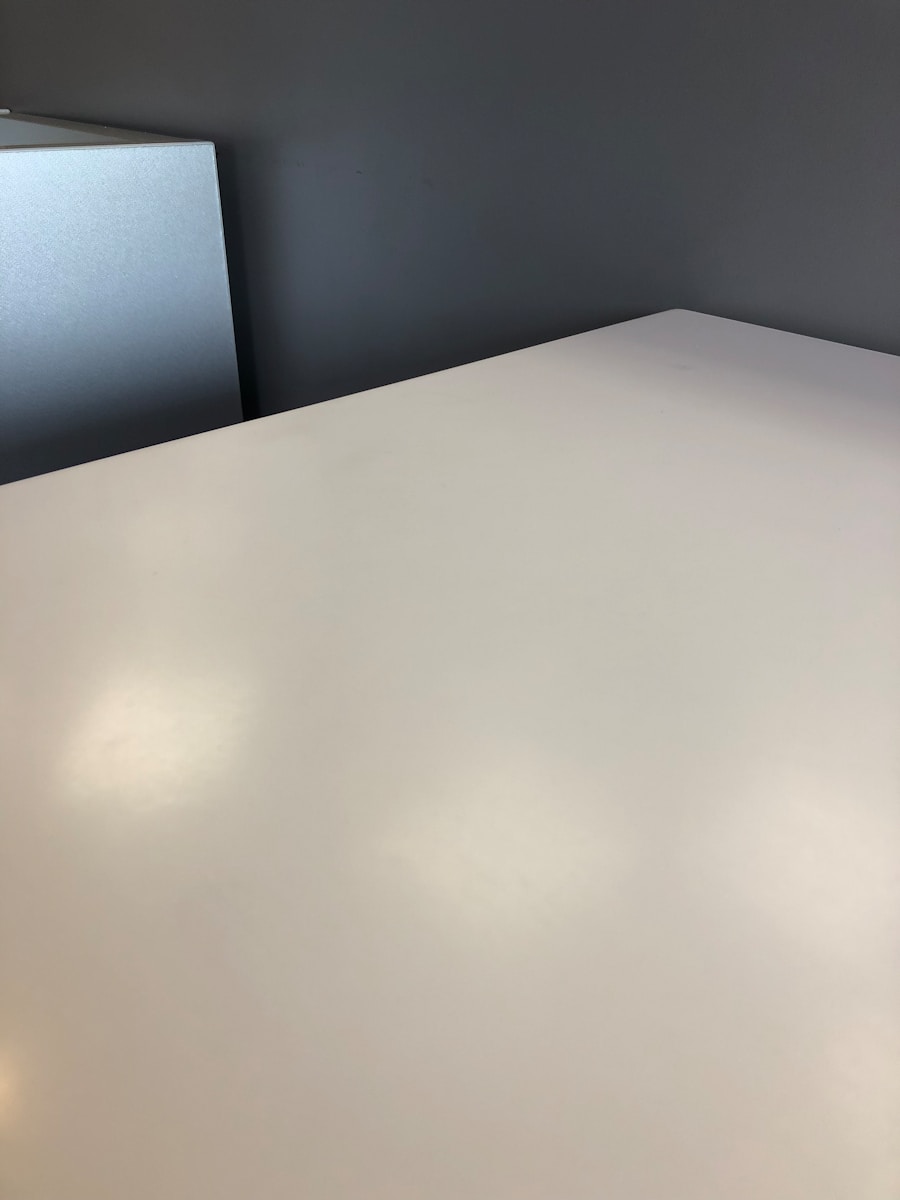The meeting table serves as a focal point in any collaborative environment, whether it be in a corporate office, a creative studio, or a community center. Its primary purpose is to facilitate discussions, brainstorming sessions, and decision-making processes among team members. Understanding this purpose is crucial for selecting the right table that meets the specific needs of the organization.
For instance, a tech startup may require a table that encourages open dialogue and creativity, while a law firm might prioritize a more formal setup that reflects professionalism and authority. Moreover, the purpose of the meeting table extends beyond mere functionality; it also plays a significant role in shaping the dynamics of interactions. A round table can promote equality among participants, fostering an atmosphere where everyone feels comfortable contributing.
In contrast, a rectangular table may create a more hierarchical environment, which can be beneficial in situations where leadership needs to be clearly defined. Therefore, when choosing a meeting table, it is essential to consider not only the practical aspects but also how the design and layout will influence communication and collaboration among team members.
Key Takeaways
- The purpose of the meeting table should align with the goals and objectives of the meetings being held.
- The size and shape of the table should be chosen based on the number of participants and the type of discussions taking place.
- Material and durability are important factors to consider when selecting a meeting table, as it should be able to withstand regular use and potential wear and tear.
- Aesthetic and style should complement the overall design and decor of the meeting space, while also reflecting the company’s brand and image.
- Functionality and features such as built-in power outlets, cable management, and storage options should be considered to enhance productivity and convenience during meetings.
- Budgeting for the right table involves balancing cost with quality and functionality to ensure a worthwhile investment.
- Ergonomics and comfort are crucial for creating a conducive and comfortable environment for productive meetings.
- Selecting the right supplier or manufacturer is essential for ensuring quality, timely delivery, and reliable customer support for the meeting table.
Considering the Size and Shape of the Table
The size and shape of a meeting table are critical factors that can significantly impact its usability and effectiveness. A table that is too small may lead to cramped conditions, making it difficult for participants to engage fully in discussions. Conversely, an excessively large table can create a sense of distance among attendees, hindering effective communication.
Therefore, it is vital to assess the number of participants typically involved in meetings and choose a table that accommodates them comfortably while allowing for easy interaction. When it comes to shape, various options are available, each with its own advantages. Rectangular tables are often favored for formal meetings and presentations, as they provide a clear structure and can accommodate more people in a linear arrangement.
On the other hand, oval or round tables are ideal for brainstorming sessions or collaborative discussions, as they eliminate the head-of-the-table dynamic and encourage equal participation. Additionally, modular tables that can be rearranged or combined offer flexibility for different types of meetings, allowing organizations to adapt their space according to specific needs.
Evaluating Material and Durability

The material used in constructing a meeting table is another crucial consideration that directly affects its durability and longevity. Common materials include wood, metal, glass, and composite materials, each offering distinct advantages and disadvantages. Solid wood tables exude warmth and elegance, making them suitable for high-end corporate environments.
However, they may require more maintenance to preserve their appearance over time. Metal tables, on the other hand, are often more durable and resistant to wear and tear but may lack the aesthetic appeal of wood. In addition to material choice, it is essential to evaluate the construction quality of the table.
A well-constructed table should have sturdy joints and a stable base to withstand daily use. For instance, tables with reinforced legs or those designed with commercial-grade materials are better suited for high-traffic environments where they will be subjected to frequent use. Furthermore, considering factors such as scratch resistance and ease of cleaning can help ensure that the table remains in good condition over time, reducing the need for costly replacements.
Assessing the Aesthetic and Style
The aesthetic appeal of a meeting table is not merely about visual attractiveness; it also reflects the organization’s brand identity and culture. A well-chosen table can enhance the overall ambiance of a meeting space and create a welcoming environment for both employees and clients. For example, a modern tech company may opt for sleek lines and minimalist designs that convey innovation and forward-thinking, while a traditional law firm might prefer classic wooden tables that evoke a sense of trust and stability.
When assessing style, it is important to consider how the meeting table complements existing office decor and furniture. Color schemes, finishes, and design elements should harmonize with the overall aesthetic of the workspace. Additionally, incorporating elements such as branding or custom designs can further personalize the meeting area, making it more inviting for participants.
Ultimately, the right aesthetic choice can contribute to a positive atmosphere that encourages creativity and collaboration.
Thinking about Functionality and Features
Functionality is paramount when selecting a meeting table, as it should cater to various needs beyond just providing a surface for discussions. Many modern meeting tables come equipped with features that enhance their usability. For instance, integrated power outlets and USB ports allow participants to charge devices without cluttering the table with cords.
This feature is particularly valuable in today’s digital age where laptops and tablets are commonplace during meetings. Additionally, considering features such as built-in storage solutions can help keep meeting materials organized and accessible. Tables with cable management systems can prevent unsightly wires from detracting from the professional appearance of the space.
Furthermore, adjustable height tables offer flexibility for different types of meetings—whether standing discussions or seated conferences—catering to diverse preferences among team members. By prioritizing functionality and innovative features, organizations can create an efficient meeting environment that supports productivity.
Budgeting for the Right Table

Budgeting is an essential aspect of selecting a meeting table that aligns with both organizational needs and financial constraints. The price range for meeting tables can vary significantly based on factors such as size, material, design complexity, and brand reputation. It is crucial to establish a budget early in the decision-making process to avoid overspending while still ensuring quality.
When budgeting for a meeting table, organizations should consider not only the initial purchase price but also long-term costs associated with maintenance and potential replacements. Investing in high-quality materials may result in higher upfront costs but can lead to savings over time due to increased durability and reduced need for repairs or replacements. Additionally, exploring options such as leasing or purchasing used furniture can provide cost-effective alternatives without compromising on quality or functionality.
Considering Ergonomics and Comfort
Ergonomics plays a vital role in creating a conducive meeting environment that promotes comfort and productivity among participants. A well-designed meeting table should accommodate various body types and preferences while ensuring that all attendees can engage comfortably during discussions. For instance, tables with appropriate height allow participants to sit or stand without straining their backs or necks.
In addition to height considerations, incorporating comfortable seating options is equally important. Chairs that provide adequate lumbar support can enhance comfort during long meetings, reducing fatigue and distractions. Furthermore, ensuring sufficient legroom under the table allows participants to shift positions easily without feeling cramped.
By prioritizing ergonomics in the design of meeting spaces, organizations can foster an environment that encourages active participation and engagement.
Selecting the Right Supplier or Manufacturer
Choosing the right supplier or manufacturer is crucial in ensuring that the selected meeting table meets all specified requirements regarding quality, design, and functionality. Researching potential suppliers involves evaluating their reputation within the industry as well as their track record for delivering high-quality products on time. Reading customer reviews and testimonials can provide valuable insights into their reliability and customer service.
Additionally, engaging with suppliers who offer customization options can be beneficial for organizations seeking unique designs tailored to their specific needs. A reputable manufacturer should be willing to collaborate closely with clients to understand their requirements fully and provide solutions that align with their vision. Furthermore, considering factors such as warranty policies and after-sales support can help ensure that organizations receive ongoing assistance should any issues arise post-purchase.
By carefully selecting suppliers who prioritize quality and customer satisfaction, organizations can invest in meeting tables that enhance their collaborative efforts effectively.
When it comes to office furniture, meeting tables play a crucial role in facilitating collaboration and productivity. In addition to meeting tables, having stylish and comfortable seating options like sofas can also enhance the overall look and feel of a meeting room. For those looking to create a modern and luxurious office space, investing in high-quality executive desks is essential. To learn more about stylish sofa options from Dubai, check out this article for some inspiration.
FAQs
What are office meeting tables?
Office meeting tables are furniture pieces designed for use in office meeting rooms or conference rooms. They are used as a surface for employees to gather around for meetings, discussions, and collaborative work.
What are the different types of office meeting tables?
There are various types of office meeting tables, including rectangular tables, round tables, oval tables, boat-shaped tables, and modular tables. Each type serves a different purpose and can accommodate different numbers of people.
What materials are office meeting tables made of?
Office meeting tables are commonly made of materials such as wood, metal, glass, or a combination of these materials. The choice of material often depends on the desired aesthetic, durability, and budget.
What are the features to consider when choosing office meeting tables?
When choosing office meeting tables, it’s important to consider factors such as size, shape, material, design, functionality (e.g., cable management, power outlets), and the number of people it can accommodate. Additionally, considering the overall office decor and style is important for a cohesive look.
How can office meeting tables contribute to a productive work environment?
Office meeting tables can contribute to a productive work environment by providing a designated space for collaboration, brainstorming, and decision-making. They can also enhance communication and teamwork among employees, leading to more efficient and effective meetings.


